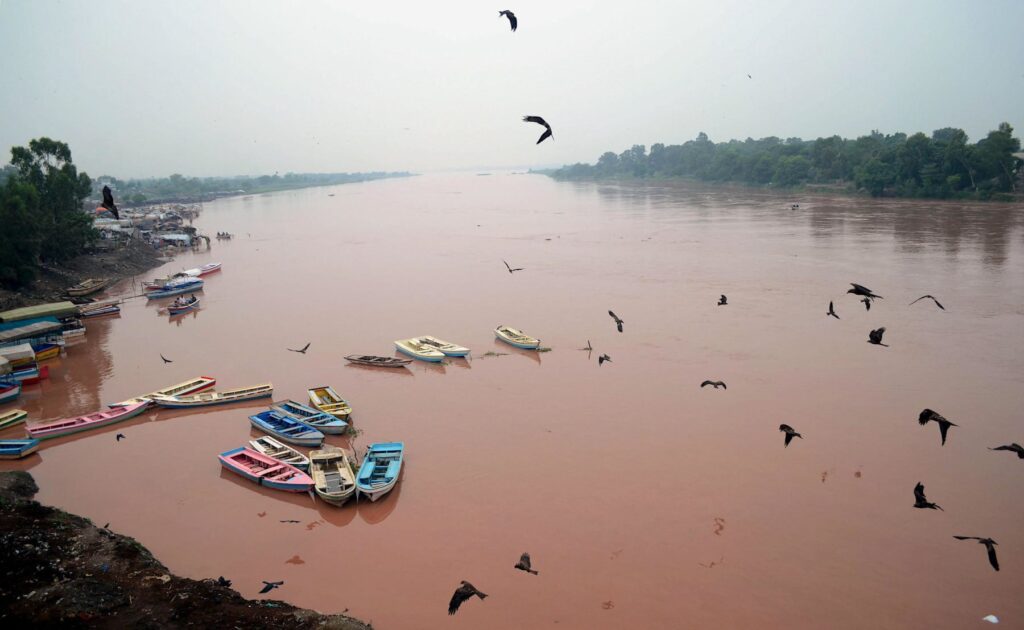Of India-Pak Cooperation For Water Security
Mar 11, 2024 | Pratirodh Bureau
A view of the bank of the Ravi River in Lahore (Image: Rana Sajid Hussain/Alamy)
As the Shahpurkandi barrage on the river Ravi in the Indian state of Punjab nears completion, there are fears in downstream Pakistan. The dam, proposed three decades ago, has the potential to irrigate 5,000 hectares of agricultural land in Punjab and over 32,000 hectares in Jammu and Kashmir on the Indian side. But the dam will stop any flow of river water to downstream Pakistan, with newspaper headlines being largely dominated by accusations of ‘water war-mongering’.
The Ravi is part of the six rivers of the Indus basin that are governed by the Indus Waters Treaty (IWT). Signed in 1960 between the two countries, the IWT is one of only two major transboundary water treaties in South Asia (the other being the 1996 Ganges treaty), considered one of the great successes of water diplomacy.
The Third Pole invited two experts – Erum Sattar of Pakistan and Uttam Kumar Sinha from India – to weigh in on what the development means for the IWT as well as the long-term impacts on the Indus basin in ecological terms.
Erum Sattar, Water law expert with a doctorate from Harvard Law School
The latest controversy over the Shahpurkandi Dam and its completion by India is akin to a ‘nothing burger’ — a controversy that rages for some time mainly on social media and a lot of talk about nothing. Reasonable people should meet it by responding with the request to ‘move along, please’, as there is nothing to see here. With that overall perspective laid out, it is important to dive briefly into the details of what the IWT does and does not allow.
The IWT remains to date the only treaty in the world that diverts and divides actual rivers and not their flows or specific amounts of water. It assigned the three western rivers of the Indus basin to Pakistan whereas the three eastern rivers were allocated to India. The main thing to know about this division is that it was meant to create certainty, so that after the conclusion of the treaty, both countries would become entitled to construct the infrastructure needed to undertake full utilisation of the waters of the rivers allocated to them.
Because water flows downstream, any flow that India did not previously utilise upstream within its territory would naturally flow down to Pakistan. In the case of the present dam and controversy, this is precisely what was happening with the flows of the Ravi that were not, until now, diverted upstream within India.
But just because the treaty allows maximum utilisation by the two countries of ‘their’ respective rivers does not mean that the countries should not reach agreement and make provisions for environmental flows – even if that means making addendums to the IWT.
As environmentalists have long pointed out, by not creating provisions for environmental flows, the hydrology and ecology of the three downstream eastern rivers is irreparably harmed. Moreover, the growing complexity and changing patterns of precipitation and river flow, as a result of accelerated glacial melt and climate change, make water management much more complex than was understood at the time the treaty was negotiated.
Rather than focusing on India’s creation of projects within its territory, Pakistan should take the opportunity to have a holistic conversation about what good neighbourly conduct entails given the realities of climate change. Pakistan should put together a proposal under Article 7 of the treaty that creates the basis for future cooperation along the Indus River system. It should share its best-use ideas with India and the world immediately. Given its dependence on judicious and forward-thinking management of the rivers of the Indus, this is the need of the hour. Anything else is a distraction.
For the purposes of gaining a clearer understanding of the present controversy, it is not important to dive into the intricacies of international water law and the competing concepts of no appreciable harm and equitable utilisation. Nor to directly address whether and to the extent there are specific and general reservations on Pakistan’s end as there have been through the long history of Indus negotiations about being the lower riparian to a large upstream neighbour on both the western and eastern rivers.
Every ‘crisis’ can be an opportunity. And right now, Pakistan as a vital custodian of the Indus should adopt a visionary, expansionist and positive approach. It should propose a plan focused on expanding cooperation across the Indus River Basin for long-term sustainability amid extreme climate change. This approach should encompass all human users and non-human species and ecology across Pakistan, India, Afghanistan and China. This way, Pakistan can be on the right side of history even before international water law and perhaps other co-riparians agree to manage the basin for present and future vitality. Being right and visionary is important, while actively working towards the realisation of hope for the virtuous alignment of geopolitics and national interests.
Uttam Kumar Sinha, senior expert on transboundary rivers, author of Indus Basin Uninterrupted: A History of Territory and Politics from Alexander to Nehru
Any impression that the Shahpurkandi project is designed to deliberately prevent water flowing into Pakistan is misinformed. That said, due to the poor understanding of the IWT, there is a perceived notion that India is using the waters of the rivers as a tool to punish Pakistan.
 During the long years of negotiations, Indian negotiators were conscious of water requirements for India’s development plans, irrigation facilities and power. It was crucial, therefore, to get the waters of the eastern rivers for the proposed Rajasthan canal (now called the Indira Gandhi canal) and the Bhakra Dam on the Sutlej River. Without these waters, both the Indian states of Punjab and Rajasthan would be left dry, severely hampering India’s food production.
During the long years of negotiations, Indian negotiators were conscious of water requirements for India’s development plans, irrigation facilities and power. It was crucial, therefore, to get the waters of the eastern rivers for the proposed Rajasthan canal (now called the Indira Gandhi canal) and the Bhakra Dam on the Sutlej River. Without these waters, both the Indian states of Punjab and Rajasthan would be left dry, severely hampering India’s food production.
While it was important to protect India’s interest on the eastern rivers, this was not done at the cost of reduced water supplies to Pakistan. It is useful, therefore, to read the provisions on the eastern rivers in the IWT, which stipulates India’s unrestricted use of the waters of the eastern rivers and, in particular Article II, which explicitly states that India has full rights over the use of Ravi waters before they cross into Pakistani territory.
The debates on the IWT within India largely fall into three categories. First, is about the need to replace the IWT with another improved one – an Indus Water Treaty-II. The second argument is to abrogate it and utilise the provisions of the treaty to inflict pain on Pakistan as a countermeasure.
Those advocating revision argue that the treaty is outdated in the sense that it does not take into account new realities and grounds for cooperation such as the proper survey of the basins for better exploitation of water resources; reconsideration of the interests of Kashmiris whose interests were overlooked; and new technologies being used for dam-making, de-siltation and ecological issues, among others.
The advocates of abrogation, however, argue that the treaty has unjustly signed away more waters to Pakistan than it rightfully deserved and has not ensured friendly behaviour from Pakistan.
But there is a third perspective that centres around the optimal use of treaty provisions. Those advocating this hold that India has been lackadaisical by not using the provisions of the treaty to good effect. India has not built the infrastructure for the full use of the waters of the eastern rivers like the Ravi, or the “permissible storage capacity” it is granted on the western rivers by the IWT. This is especially important as India faces water scarcity.
The key water projects prioritised since 2014 on the Indus rivers by India all focused on the optimal use of water as under the IWT. These include the Shahpurkandi Dam, the Ujh project in Jammu & Kashmir, and the 2nd Ravi Vyas Link Project in Punjab on the eastern rivers. On the western rivers, the Bursar Multipurpose Project in Jammu and Kashmir, and a second multi-purpose project being planned is the Gyspa on Bhaga River (Chenab Main) in Lahaul & Spiti district of Himachal Pradesh. There is also a strong opinion that the Tulbul Navigation Project, to which Pakistan objected and which remains stalled, must now be completed.
While it is important to seriously look at what can be done within the framework of the IWT to foster cooperation given the changing Indus basin dynamics, there are two important caveats from the Indian perspective. Firstly, the idea that India is striving to acquire capacity to manipulate or withhold the flow of water from Pakistan must be set aside. It is untenable under the provisions of the IWT and it would be easy to monitor such actions. Secondly, India feels that a section of Pakistan’s leadership is raising issues to distract from its own internal water management failures and a bid to gain international attention, yet again, to Kashmir. These hamper any realistic chances of cooperation.
(Published under Creative Commons from The Third Pole. Read the original article here)
